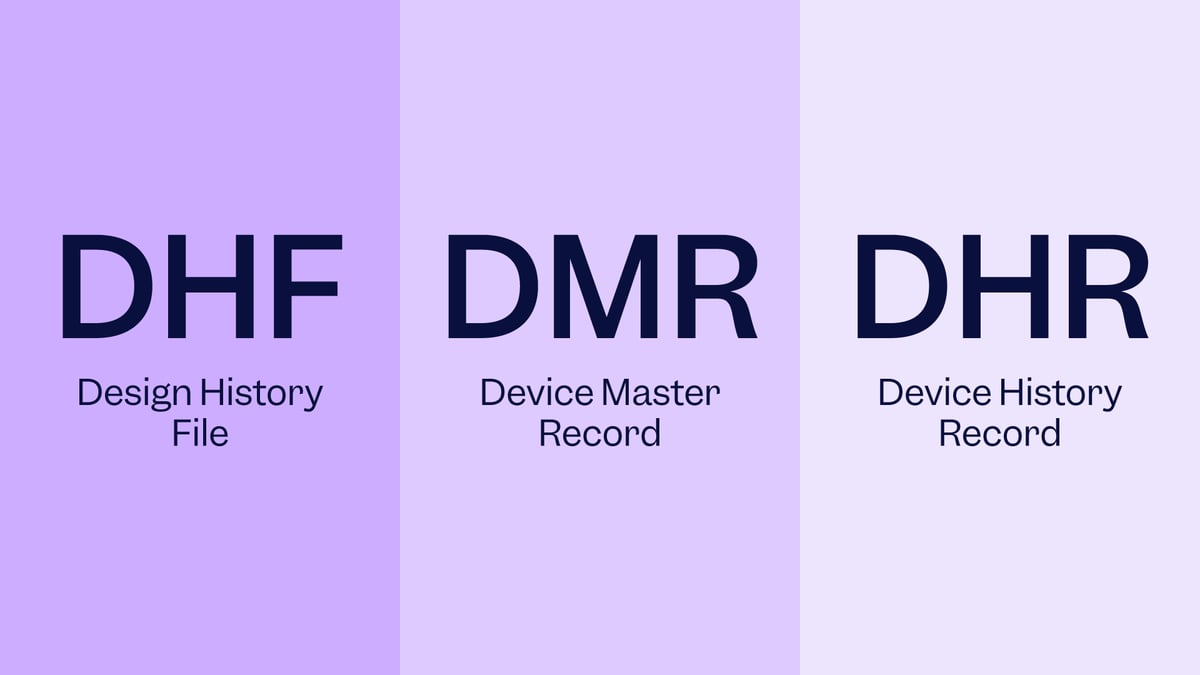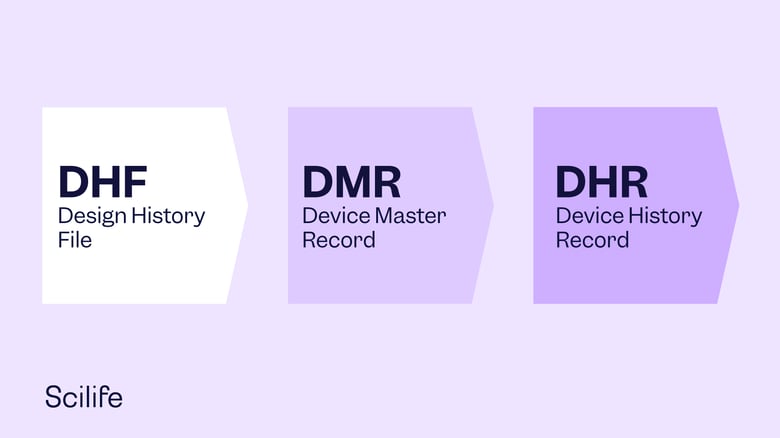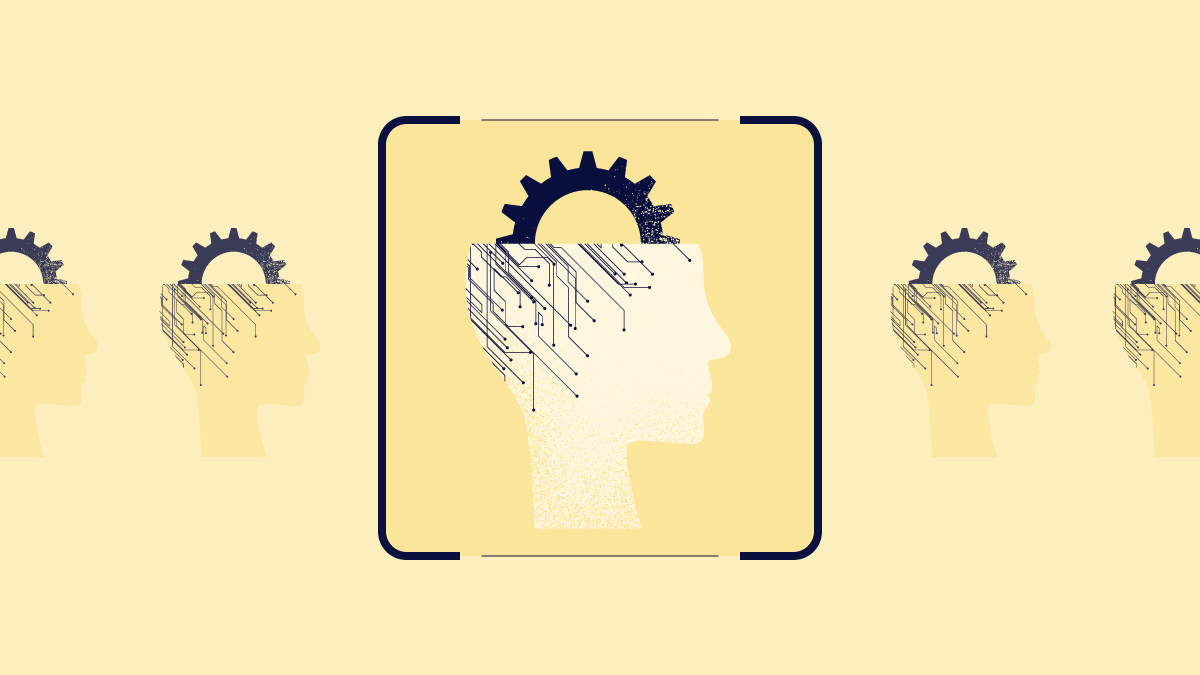
In the medical device industry, there are tons of abbreviations. And as a medical device professional you can easily get lost in this acronym ocean! The most important (and most confusing) abbreviations are DHF, DMR, and DHR. These three abbreviations are commonly used by the FDA in medical device quality regulation:
- DHF - Design History File
- DMR - Device Master Record
- DHR - Device History Record
Although they sound almost the same, they are quite different and can contain different documents generated in different steps of the design process. They are the required documents that medical device manufacturers should create and make available for auditors to show the compliance of the medical device to achieve FDA approval - and therefore access to the US market.
What Do DHF, DHR, and DMR Stand For?
DHF - Design History File
The Design History File (DHF) documents how the instruction manual was designed and compiled. A DHF must contain or refer to the documentation of design reviews, validation, controlled design, and approved design inputs and output.
The 21 CFR 820.30, states that “each manufacturer shall establish and maintain a DHF for each type of device.”
DMR - Device Master Record
The Device Master Record (DMR) can be considered an instruction manual for the compliant manufacture of the medical device. A DMR must contain or refer to the information that is required to build the device including specifications, acceptance criteria, drawings, BOMs (Bill of Materials), and maintenance/servicing procedures.
The FDA mandates DMRs for each type of medical device according to 21 CFR 820.181,
DHR - Device History Record
The Device History Record (DHR) must contain all documents to prove that the instruction manual has been followed while manufacturing the medical device. A DHR must contain or refer to the date of manufacturing, the quantity, and the acceptance records of manufactured medical devices, as well as the unique device identifier (UDI) or any other unique device labels.
The FDA mandates that each manufacturer shall establish DHRs for each batch, lot, or unit produced based on 21 CFR 820.184.
Those three important documents are mandated by the FDA. Although there is no direct requirement for those terms, ISO 13485:2016 combines the DHR and DMR into the Medical Device File (MDF).
The Difference Between DHF, DHR, and DMR
DHF, DHR, and DMR are all crucial parts of the design process of a medical device developed in accordance with FDA regulations. Even though these abbreviations sound very similar and confusing at first, here is a quick trick so you will never confuse them again:
Focus on the last letter. The “R” stands for “record” and means that the abbreviation must be related to the “device” and not the “design.” This will automatically tell you what the first letter “D” stands for.

- The Design History File recounts the history of the design and ensures that it is designed according to FDA regulations.
- The Device Master Record focuses on manufacturing the device and ensures that all required activities are included to build, test, package, and service it.
- The Device History Record compiles the documents that are used to manufacture the medical device.
The process begins with the history of the design (the DHF) and continues to record how the device (the DMR) was manufactured and tested. Then it continues with the history of the device (the DHR) that contains all info on how the device is built.
|
Design History File (DHF) |
Device Master Record (DMR) |
Device History Record (DHR) |
|
|
|
The Difference Between DHF and DDF
In the development stage, the Design History File (DHF) needs to enable auditors to evaluate the compliance and consistency of the design controls. This documentation should contain all evidence, documents, and records to meet the requirements in terms of design and development – including any changes made to the medical device. In the EU, there is a similar requirement termed the Design and Development File (DDF), as defined in ISO 13485.
The Difference Between DMR and MDF
The Device Master Record (DMR) describes the stage of transferring the design to the manufacturing of the medical device. In this stage, you need to combine all relevant manufacturing records to generate the DMR.
In the US, the FDA 21 CFR 820.181 defines a DMR as a required set of records that contains all parts, specifications, and designs necessary to build a medical device.
In the EU, ISO 13485 demands a similar Medical Device File (MDF), which can be thought of as the European equivalent to the DMR.
| Development | Manufacturing | |
|
Required documents |
Design and Development File (DDF) Design History File (DHF) |
Device History Record (DHR) Device Master Record (DMR) Medical Device File (MDF) |
| US FDA | DHF - 21 CFR 82.30 |
DMR - 21 CFR 820.181 DHR - 21 CFR 820.184 |
| ISO 13485 | DDF - 7.3.10 | MDF - Clause 4.2.3 |
Conclusion
So what is the best way to build your DHF, DMR, and DHR documentation? If you haven’t continuously collected documents during the design process, it can often become demanding to find or create files after the fact. Additionally, pulling together and saving files in different locations can be a time-consuming and error-prone process, leading to further delays, internal friction, confusion, and dangerous documentation duplication.
The FDA mandates manufacturers to have and demonstrate the latest and approved version of all documents under the DHF and DMRs, with a full version history. In order to meet this requirement, you will need an organized, accessible, and secure place for these documents. That is why choosing the right digital document management system is crucial. This can allow you to find any document with ease and can also enable you to revise and synchronize different parts of the system. Additionally, you will be able to fully digitize the production documentation process and keep all documents audit-ready – with little to no additional effort. The right digital document management system will not only save you money and time, but will also provide peace of mind while you design, manufacture, and manage your device throughout its lifecycle.
How Scilife Can Help
Our team at Scilife can help you with getting the DHFs, DMRs, MDFs, and DHRs in order, as well as with maintaining, updating, and synchronizing your complete documentation. Consider these crucial features when choosing a document management system:
- Creating projects
- Creating document templates and getting approval for the templates
- Defining the contents of critical files at the beginning of each project
- Populating documents with approved content automatically
- Providing a version history for each document
- Having the latest approved files (DMFs, DMRs, and DHRs) collated and available to auditors







